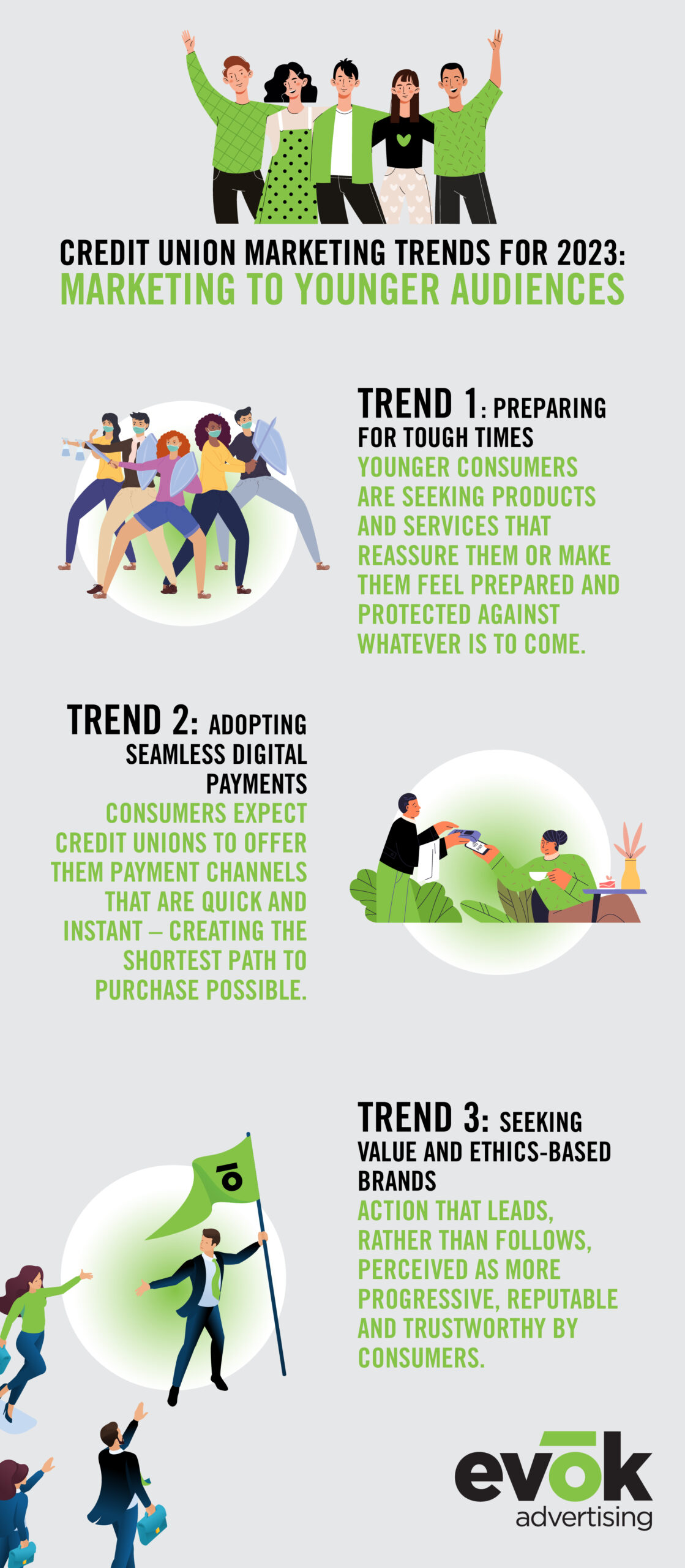
Credit Union Marketing Trends for 2023: Marketing to Younger Audiences
As credit unions and other financial institutions prep for the new year ahead, our team got to work identifying major consumer mindset and behavior trends coming or continuing into 2023 with a focus on Millennial and Gen Z audiences. From taking steps to prep for financial uncertainty to embracing digital and aligning their values to their brand choices, our credit union marketing team translated these findings into key takeaways specific to financial institutions looking to appeal to young consumers.

Trend 1: Preparing for Tough Times
Nearly half (43%) of US consumers say they are most concerned about rising prices (i.e. inflation) over the next six months. American consumers also report financial flexibility is an increased priority due to the COVID-19 pandemic. During and following periods of financial uncertainty, as with a looming recession and inflation surges, individuals may be reluctant to spend, but also exhibit a desire for things that promise durability or protection, whether physical or emotional.
While older generations will remember the hardships of previous decades, such as the recession and housing collapse of 2008, younger consumers may be facing these challenges on their own for the first time. Millennials who remember any struggles their parents dealt with during the last recession may be particularly wary. Many have adopted something of a “bunker mentality” and are looking to prevent, prepare and save ahead of potential further downturn. This may present in the shape of increased savings, but also seeking new or improved ways to protect personal information.
Advances in tech have enabled brands and businesses to ease consumer worries, specifically in the financial services industry. Growing smartphone ownership, the rise of connected devices and improved internet connectivity mean that people can receive alerts and proactively check on their accounts much more easily than ever before, allowing their fears to be quelled instantly. With consumers on high alert at every turn, brands are and must continue to integrate safety and security measures into products and services as standard. Ensuring that people are better protected without requiring any additional input or action on their part will be key to appealing to those who are both safety conscious and time conscious.
Key Takeaways for Credit Union Marketing
- Younger consumers are seeking products and services that reassure them or make them feel prepared and protected against whatever is to come.
- Credit unions that can make protecting or preventing financial issues, such as identity theft, overdraft fees, risky investment losses and more, simple will appeal to time-pressed consumers.
- Consumers will invest in quality and durability, so putting proof front and center of advertising campaigns and marketing messages will be key.
Trend 2: Seamless Digital Payments
These days, almost anybody can pay using a smartwatch, smartphone, or contactless credit or debit card – PINs and signatures are practically a thing of the past. With consumers, particularly the younger generations, always on the lookout for convenience and speed, digital payment technologies have been proven to offer both and continue to rise in adoption and as a payment preference. In fact, 43% of US consumers who own a financial product expect to use cash less often moving forward.
Tying back to the topic of security from the previous trend, digital payments were once considered less secure than cash or cards. However, consumers are starting to realize smartphone payments can be just as secure, if not more so, than traditional transactions. For example, smartphones with thumbprint scanners can ensure that only the person whose phone it is can authorize payments.
Further, digital currencies, such as Bitcoin, are breaking into the conventional finance world. As people of all ages become more used to paying digitally – using apps, platforms and their smartphones themselves – increased literacy in digital payments could lead to more people experimenting with digital currencies.
Moving into 2023, younger credit union members will expect and demand these technologies. With Apple and Google already offering tech solutions, credit unions that fail to keep up may appear stuck in the past. But institutions willing to go the extra step could well be key players in helping consumers understand and adopt digital payments. Your credit union could host educational events, workshops or classes to teach members about cashless spending, not only attracting the next generation of banking consumers but extending this product line to those not quite as fluent in digital payments.
Key Takeaways for Credit Union Marketing
- Consumers expect and will begin to demand credit unions to offer payment channels that are quick and instant – creating the shortest path to purchase possible.
- Credit unions may be able to utilize mobile and digital payment technologies to challenge conventional ways of selling products and services. Do your members need to be local or can you expand your reach?
- The act of spending intangible money will not just encourage spontaneous purchases, but could also see people lose track of the real value of money. Credit unions may have an opportunity to help members keep a grip on the real-life consequences of spending with financial literacy resources and education-focused marketing.
Trend 3: Value and Ethics-Based Membership
Over half (58%) of Gen Zs aged 18-24 who have shopped online in the last 12 months say they buy from brands/retailers that share and act on their values. Further, 67% of US Millennials who have shopped online in the last 12 months say they research brands they’re not familiar with to understand their values and what they stand for. It is clear, younger consumers demand comprehensive value-based initiatives from brands, increasingly expecting brands to take action in regard to justice, inclusivity and sustainability in every aspect of their businesses. This action extends beyond corporate social responsibility programs, but rather it is expected across product and service lines. By demonstrating awareness of sociopolitical issues through everything from products to marketing, credit unions can show potential young members they understand their concerns, values and ethics, and work to address them in a connected, holistic way.
For value-driven audiences, a company’s corporate social responsibility or a product’s implications can act as a differentiator or even a deal-breaker. When offered a choice, younger consumers will increasingly choose a brand that aligns with their values, often paying more for the same or similar product or service. Because of this, communicating your institution’s values clearly and prominently is key. From community impact to your credit union’s not-for-profit categorization or ADA-compliant web presence, credit unions must not only take action but also share the outcome of those actions.
As consumers look for credit unions to be charitable, ethical or environmentally responsible at both local and global levels, “doing the work” might not just the right thing to do, it can directly impact member acquisition and retention amongst younger populations.
Key Takeaways for Credit Union Marketing
- Most brands have CSR policies, but credit unions looking to tap into the Millennial and Gen Z market need to stand out through real-world initiatives such as community involvement, charity events and donation matching.
- Credit unions can further embed themselves in their communities by promoting social banking initiatives that offer special rates to environmental and charitable organizations.
- Credit unions that go beyond the legal requirements and take action towards a moral stance that leads, rather than follows, will be seen as more progressive, reputable and trustworthy by consumers.
We hope the insights shared in this article have been helpful as you set your sights on next year’s goals. As always, should your credit union have a need for further direction on how to tap into the Millennial and Gen Z market, our team is just a few clicks or a call away.